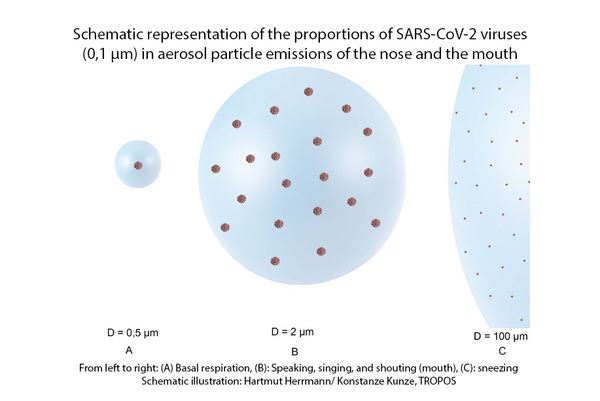Covid-19 and the role of aerosol particles - Statement of the Working committee particulate matter (AAF) of DECHEMA/ProcessNet, GDCh and KRdL
Aerosols and their spread play an essential role in the transmission of COVID-19. However, the risk of transmission could be significantly reduced if more could be done to reduce indoor airborne viruses. The Working committee particulate matter (AAF) has therefore issued an statement with concrete recommendations:
Covid-19 and the role of aerosol particles
- Statement of the Working committee particulate matter (AAF) of DECHEMA/ProcessNet, GDCh and KRdL
08 December 2020
https://www.tropos.de/fileadmin/user_upload/Aktuelles/News/Bilder/Bilder_2020/201208_Covid19-Aerosol_AAF_Vs9__en.pdf
The Working committee particulate matter (AAF) is a body of the following scientific associations: DECHEMA (Gesellschaft für Chemische Technik und Biotechnologie e.V. Frankfurt; ProcessNet: Platform for Chemical Process Engineering of DECHEMA and VDI-GVC (with VDI: Verein Deutscher Ingenieure e.V., Düsseldorf and GVC:Gesellschaft für Verfahrenstechnik und Chemieingenieurwesen im VDI e.V. Düsseldorf; GDCh (Gesellschaft Deutscher Chemiker e.V., Frankfurt) and KRdL (VDI/DIN Commission Reinhaltung der Luft (KRdL) - Standards Committee, Düsseldorf).
This statement is supported and co-sponsored by the Leibniz Institute for Tropospheric Research (TROPOS) and the Gesellschaft für Aerosolforschung (GAeF).
The statement was drafted by H. Herrmann, P. Wiesen, R. Zellner and C. Zetzsch with contributions from E. Hösen-Seul, W. Koch, U. Krämer, G. Lammel, A. Mayer, S. Metzger, S. Nehr, U. Pöschl, E. Schmidt and K. Schwarz.

